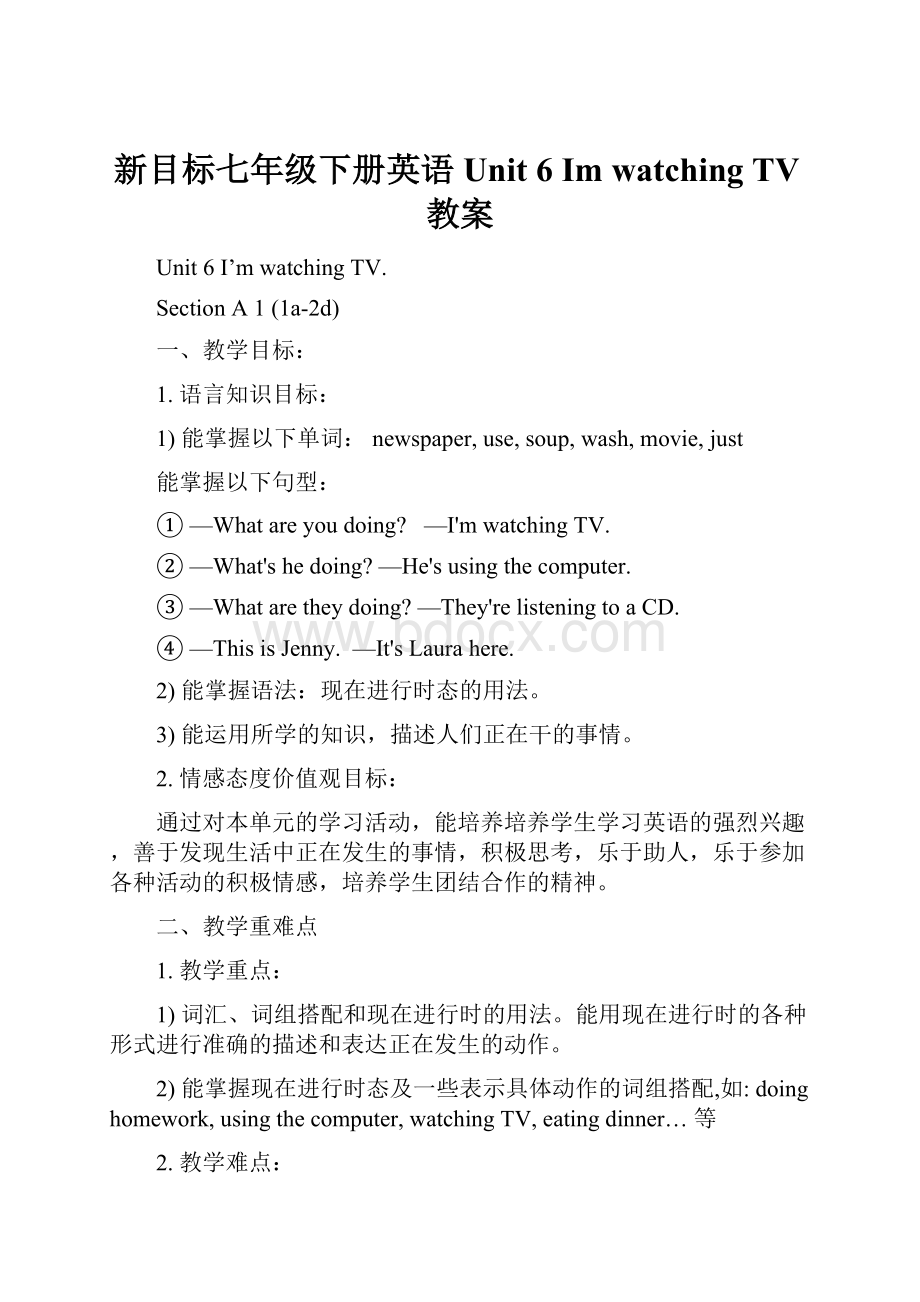新目标七年级下册英语Unit 6 Im watching TV教案.docx
《新目标七年级下册英语Unit 6 Im watching TV教案.docx》由会员分享,可在线阅读,更多相关《新目标七年级下册英语Unit 6 Im watching TV教案.docx(17页珍藏版)》请在冰豆网上搜索。

新目标七年级下册英语Unit6ImwatchingTV教案
Unit6I’mwatchingTV.
SectionA1(1a-2d)
一、教学目标:
1.语言知识目标:
1)能掌握以下单词:
newspaper,use,soup,wash,movie,just
能掌握以下句型:
①—Whatareyoudoing?
—I'mwatchingTV.
②—What'shedoing?
—He'susingthecomputer.
③—Whataretheydoing?
—They'relisteningtoaCD.
④—ThisisJenny.—It'sLaurahere.
2)能掌握语法:
现在进行时态的用法。
3)能运用所学的知识,描述人们正在干的事情。
2.情感态度价值观目标:
通过对本单元的学习活动,能培养培养学生学习英语的强烈兴趣,善于发现生活中正在发生的事情,积极思考,乐于助人,乐于参加各种活动的积极情感,培养学生团结合作的精神。
二、教学重难点
1.教学重点:
1)词汇、词组搭配和现在进行时的用法。
能用现在进行时的各种形式进行准确的描述和表达正在发生的动作。
2)能掌握现在进行时态及一些表示具体动作的词组搭配,如:
doinghomework,usingthecomputer,watchingTV,eatingdinner…等
2.教学难点:
现在进行时中现在分词的结构及读音,能在交际中准确地运用现在进行时来描述或表达正在进行的动作。
三、教学过程
I.Presentation
1.Showsomepicturesonthebigscreen.Presentthenewwordsandexpressions.
2.Sswatchandlearnthenewwordsandexpressions.
3.GiveSssometimeandtrytorememberthenewwordsandexpressions.
4.(Showsomepicturesonthescreenandasksomestudentstoperformtheactions.)
e.g.T:
Whatareyoudoing?
S:
Iamdoinghomework.(Helphim/hertoanswer)
T:
Whatishe/shedoing?
Ss:
He/sheisdoinghomework.
Teach:
watchingTV,cleaning,readingabook,eatingdinner,talkingonthephone...asthesameway.
5.Workon1a.Ssreadtheactivitiesandlookatthepictures.Thenmatchtheactivitieswithpictures.
6.ChecktheanswerswiththeSs.
IIListening
1.T:
WhatareJenny,John,DaveandMarydoing?
Nowlet’slistentothetape,findouttherightactivitiesfrom1a.
2.PlaytherecordingfortheSstwice.
3.Sslistentotherecordingandwritethenumbersfrom1a.
4.Practice
III.Pairwork
1.AsktheSstoreadtheconversationsin1cwithapartner.Thenlookatthepicturesin1a.Andconversationsaboutotherpersoninthepicture.
2.Ssmakeconversationsbythemselvesandpracticetheconversations.
IV.Listening
1.Workon2a;
T:
JackandStevearetalkingonthephone.Whataretheydoingnow?
Listentotheconversationsandmatchtheanswerswiththequestions.
(Playtherecordingforthefirsttime,studentsonlylistencarefully.Then,listentotherecordingagain,andmatchtheanswerswiththequestions.)
Checktheanswers.
2.Workon2b.
LetSsreadtheconversationin2bfirst.ThenplaytherecordingfortheSstwice.
ThefirsttimeSsonlylistenandwritedownthewordsintheblanks.ThenplaytherecordingagainfortheSstochecktheanswers.(Ifnecessary,pressthePausebuttontohelp.)
V.Pairwork
1.Now,role-playtheconversationwithyourpartners.
2.Letsomepairstoactouttheconversationinfrontoftheclass.
VI.Role-play
1.AskSstoreadtheconversationin2dandmatch.
2.ChecktheanswerswiththeSs.
3.LetSsworkinpairsandrole-playtheconversation.
VII.Languagepoints
1.ThisisJenny.我是詹妮。
这是打电话用语。
打电话介绍自己时用“Thisis…”或“It’s…”;询问对方用“Isthat…?
”或“Who’sthat?
”。
例如:
—Hello?
ThisisBob,who’sthat?
喂?
我是鲍勃,你是谁?
—Hi,Bob.It’sMikehere.
你好,鲍勃。
我是迈克。
2.Notmuch.(口语)没什么大事。
也可说成Nothingmuch,表示自己有空。
例如:
A:
Whatareyoudoing,Linda?
你在做什么事,琳达?
B:
Not(Nothing)much.I’mjustreadingabook.
没什么事。
我在读一本书。
3.Doyouwanttojoinmefordinner?
你想和我一起吃饭吗?
joinsomebodyforsomething表示“与某人一起做某事;参与或加入到某人的行列中一起做某事”。
例如:
Wouldyoucomeandjoinusforacupofcoffee?
Weneedtotalktoyou.
你来跟我们喝杯咖啡好吗?
我们有事要跟你谈。
4.I’dloveto.我很乐意。
1)交际用语,用于礼貌地接受他人邀请,还可以说成I’dliketo,但语气比较弱。
例如:
—Wouldyouliketocomewithustotheshow?
你愿意跟我们一起去看表演吗?
—Thanks.I’dliketo.谢谢,我愿意。
2)当委婉拒绝他人邀请时,多用I’dloveto,but...或Sorry,I’mafraidIcan’tbecause...等。
例如:
—I’mgoingtotown.Wouldyouliketojoinme?
我进城去,你想跟我一同去吗?
—Sorry,I’mafraidIcan’tbecauseIstillhavelotsofhomeworktodo.
真抱歉,怕是不成了,我还有好多作业要做呢。
VIII.Exercises
Homework:
1.总结所学过的活动,用英语写出来。
2.在家里打个电话询问一下你的某个好朋友正在做什么?
然后用英语编写成对话。
SectionA2(Grammarfocus-3c)
一、教学目标:
1.语言知识目标:
1)继续练习运用现在进行时态来谈论人们正在做的事情。
2)掌握现在时行时态的结构及用法。
3)掌握动词的现在分词形式的构成方式。
能掌握以下句型:
①—What’she/shedoing?
—She's/He'swashingtheclothes.
②—Whataretheydoing?
—TheyarelisteningtoaCD.
③—Ishereadinganewspaper?
—Yes,heis./No,heisn't.
④—Aretheyusingthecomputer?
—Yes,theyare./No,theyaren't.
2.情感态度价值观目标:
培养同学间的友好相处,规范自己的行为,同时能提高他们的观察能力和判断能力,激发他们对学习英语的兴趣和热情,在接近生活常态的交际中能乐于模仿,敢于开口,积极参与,主动请教。
二、教学重难点
1.教学重点:
1)掌握现在进行时态的结构及用法。
2)通过不同形式的练习来运用现在进行时态。
2.教学难点:
1)掌握现在时行时态的结构及用法。
2)运用现在进行来描述人们正在进行的活动。
三、教学过程
Ⅰ.Warming-upandrevision
1.Haveadictationofthenewwordsandexpressions.
2.Letsomepairsrole-playtheconversationin2band2d.
Ⅱ.Grammarfocus.
1.学生阅读Grammarfocus中的句子,然后完成句子。
1)你在做什么?
_____________________
2)我在看电视。
__________________
3)她在做什么?
___________________
4)她在洗衣服。
____________________
5)他们在做什么?
___________________
6)他们在听CD。
___________________
7)你在做作业吗?
__________________________
8)是的。
/不是。
__________________________
9)我在打扫我的房间。
_____________________
10)他在读报纸吗?
_______________________
11)是的。
/不是。
他在打篮球。
________________________________
12)他们在用电脑吗?
____________________________
13)是的。
/不是。
他们在锻炼。
______________-
2.Ssworkbythemselvesandchecktheanswerswitheachother.
3.GiveSssevenmoreminutestorememberthesentences.
4.自主学习有关现在进行时态的语法知识学案
现在时行时态
一、用法:
1.表示现在(说话瞬间)正在进行或发生的动作。
例如:
我正在做作业。
I’m_______myhomeworknow.
他们在操场上踢足球。
They’re________soccerontheplayground.
2.也可表示当前一段时间内的活动或现阶段正在进行的动作。
例如:
这些天来,我们在做一架模型飞机。
Weare____________________thesedays
这个月我们一直在为英语考试而学习。
We___________fortheEnglishtestthismonth.
二、句子结构:
1.陈述句:
主语+be(am,is,are)not+V.–ing+…
我正在洗衣服。
________________________________
他正在打电话。
________________________
他们没在下象棋。
________________________
彼特没在打篮球。
_________________________
2.一般疑问句:
Be(Am,Is,Are)+主语+V.-ing…
她正在弹钢琴吗?
______________________________
你们正在做作业吗?
_____________________________
3.特殊疑问句
特殊疑问词+be(am,is,are)+主语+V.–ing…
杰克正做什么事情?
__________________
他们正在做什么事情?
____________________
三、常用时间状语:
now,rightnow或表示现在情景的Look,listen等。
格林先生现在正在写一个故事。
______________________________
看!
他们正在吃早饭。
_______________________________
四、与一般现在时态的区别
一般现在时态表示经常性、习惯性的动作;谓语动词为原形或第三人称单数形式;时间状语常为usually,often,sometimes,onMonday,everyday等。
琳达通常在早上冲澡。
___________________________________
Ⅲ.Practice
1.Workon3a.Nowlet'swritesentencesfollowingtheexamples.
指导:
这个练习题是帮助同学们理解现在时行时态与一般现在时态的区别用法;同学们应根据上述语法学习内容来造句子。
首先,应明确一般现在时态的句子结构和现在进行时态的句子结构。
然后,看提示词中的时间状语,确定是用什么时态。
然后,写出正确恰当的句子。
2.Sswritethesentenceswiththehelpofthewordsandexpressions.
3.ChecktheanswerswiththeSs.
Ⅳ.Practice
1.Workon3b.TellSstonumberthesentencesinordertomakeatelephoneconversation.Thenpracticeitwithapartner.
2.阅读指导:
首先,应明确这是一个电话会谈,因此应先通读所有的句子。
然后在理解大意的基础上,找出首句。
然后,顺藤摸瓜,依次找出下面的对话内容。
最后,通读一遍对话,看是否通顺合理。
通过读对话,可知Whatareyoudoing?
应是第一句话;这样,I'mreadingabook.就是第二句话……
3.Ssreadallthesentencesandnumbertheconversation.
4.Practicetheconversationwithapartner.
Ⅴ.Game
1.Nowlet'splayagame.Workingroups.Onestudentmakesanactivity.Theotherstudentsinthegroupsguesswhattheactivityis.Thentaketurnsmakeactivitiesandguess.
2.Ssplaythegameinagroup.
3.Teachercanwalkaroundtheclassroomandgiveanyhelpstudentsneed.
Ⅵ.Exercises
Iftimeisenough,domoreexercises.
Homework
1.RememberthesentencesinGrammarfocus.
2.Whatareyourfamilymembersdoingnow?
Writefivesentencesonwhatthey'redoingnow.
SectionB1(1a-2c)
一、教学目标:
1.语言知识目标:
1)能掌握以下单词:
pool,shop,supermarket,man,host,study,state,theUnitedStates,American,dragon,young,race,say,other,children,miss,wish,delicious,livingroom
2)能掌握以下句型:
①—WhattimeisitinBeijing?
—It'seighto'clockinthemorning.
②It's9:
00a.m.andZhuHui'sfamilyareathome.
③ZhuHuimisseshisfamilyandwishestohavehismom'sdeliciouszongzi.
2.情感态度价值观目标:
培养同学间的友好相处,规范自己的行为,同时能提高他们的观察能力和判断能力,激发他们对学习英语的兴趣和热情,在接近生活常态的交际中能乐于模仿,敢于开口,积极参与,主动请教。
了解中西方文化的不同,具有世界观念,了解其他的国家的文化。
二、教学重难点
1.教学重点:
1)掌握本课出现生的词及表达方式。
2)进一步练习运用现在进行时态的句子来描述他人在做的事情。
3)通过听、说、读的练习,提高学生们的综合运用能力。
2.教学难点
阅读短文,获得相关信息,完成相关任务。
三、教学过程
Ⅰ.Warming-upandrevision
1.Reviewtheknowledgeonthepresentprogressivetense.
2.CheckthehomeworkandletsomeSsreadtheirsentences.
Ⅱ.Presentation
1.T:
Showsomepicturesonthebigscreen.Presentsomenewwordsandexpressions.
(pool,shop,supermarket,…)
2.GiveSssometimetorememberthenewwordsandexpressions.
Ⅲ.Writing
1.Workon1a.
T:
Lookatthepicturesbelow.Wherearethey?
Whataretheydoing?
Pleaselookatthepicturesandfillintheblanks.
2.Ssworkingroups.Discussthepicturesabouttheplacesandtheactivitiestheyaredoing.Thenfillintheblanks.
3.LetsomeSsreadtheiranswerstotheclassandchecktheanswers.
Ⅳ.Pairwork
1.Workon1b.Lookatthepicturesin1a.Thenaskandanswerquestions.GiveSsamodel:
A:
Isthemanswimmingintheriver?
B:
No,heisn't.He'sswimminginapool.
2.Ssworkwiththeirpartners.Askandansweraboutthepictures.(Ifnecessary,givesomehelptotheSs.)
3.Letsomepairsaskandansweraboutthepictures.
Ⅴ.Listening
Workon1c:
1.T:
NowIwillplayarecordingofaconversation.Thistimewritetheplacesyouhearinthechart.
2.Sslistenandwritetheplaces.
3.PlaytherecordingagainfortheSstochecktheanswers.
Ⅵ.Listening
Workon1d:
1.Thistime,pleaselistentotherecordingandwritetheactivitiesyouhearinthechart.
2.Playrecordingandstopthetapeifnecessary.
3.Playthewholerecordingandhavestudentswritethewordstheyhearinthechart.
4.Checktheanswers.
Ⅶ.Pairwork
1.Workon1e.Nowlet'smakea